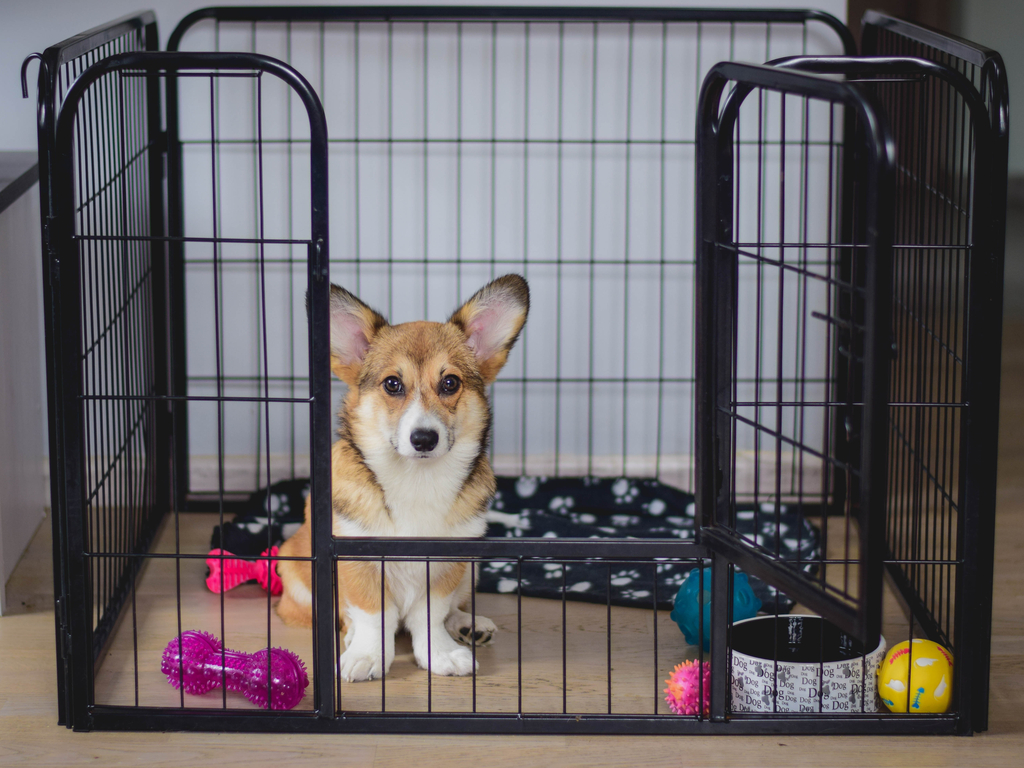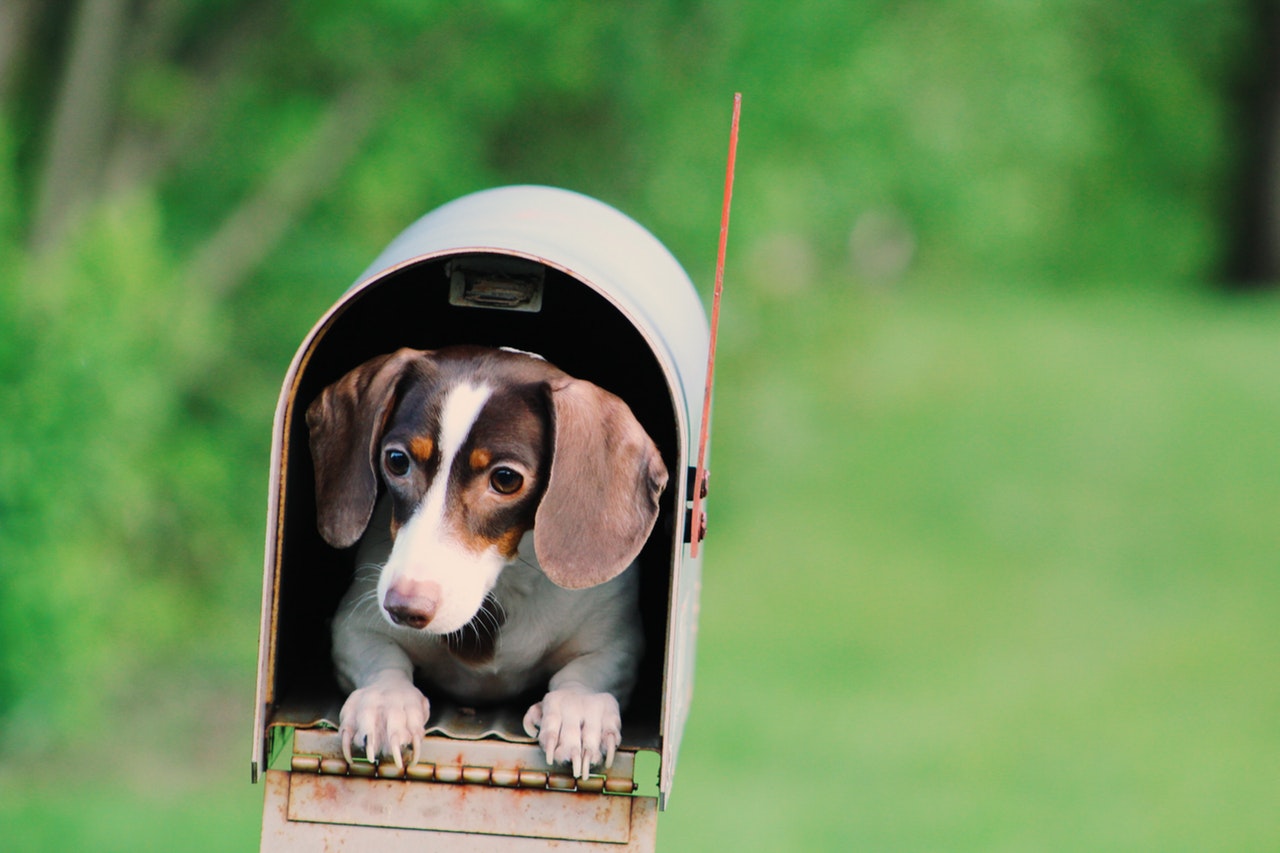Importance of crate
training puppies
 Crate training puppies takes time but the pay-off lasts a lifetime.
Crate training puppies takes time but the pay-off lasts a lifetime.Some people feel that crate training puppies is a cruel thing and admittedly, the image of a dog behind bars isn't exactly heart warming. Images aside, the truth is a crate is only cruel if we use it incorrectly or by people with bad intent.
Think of it this way; Putting a puppy in a crate is no more ill-intent (or good-intent) as putting a baby in a playpen.
Crates keep your puppy safe when you’re not with her. Crates could also save your relationship with your puppy by keeping her out of trouble due to mischief (example: destroying your paperwork) when you’re not watching.
In short, positive crate training puppies saves their lives, both directly and indirectly.
First rule
Crate training puppies will go much smoother if they are able to associate their crates with positive activities like treats, security and undisturbed rest.
Hence, the first rule for successful crate training puppies: Never use crate in any form of punishment. Most commonly as confinement cage.
To your puppy, a crate should always be a safe den where she can retreat and rest.
What size
The process of crate training should begin even before your puppy arrives! A little homework is recommended to give yourself a good idea how big your puppy breed will grow.
A good crate should last a lifetime; hence it must be big enough for your would-be full-grown dog to stand up and turn around. Yet not too big that she could section off a corner making it her toilet.
Where to place your crate
Crates should be place at the most peaceful part of your home, away from noisy children and other curious pets.
At the same time, it needs to be close enough so you can hear your puppy cry if she needs to go outside to relief at night. A good place would be your bedroom.
Never put the crate near heating or cooling vents and away from cold windy spots for that matter.
What should be in a puppy’s crate
Thick rubber matting or specific crate bedding designed to be difficult to chew up are recommended over regular cushion.
Regular cushion bed might feel more comfortable by human standard, problem is some puppies tend to chew and tear up their bedding.
Not only does this promote destructive behavior in the long run, it also creates an immediate safety hazard should your puppy swallowed chunks of indigestible material.
A variety of quality chew toys and treat-dispensing toys should also be included as her in-crate entertainment.
Steps to crate training puppies
Successful crate training puppies are all about making the crate fun and rewarding. Listed below is a breakdown in steps on how to make your puppy fall in love with her crate!
As with all training, it is also about consistency and avoiding mixed signal. If your puppy refuses to go in the crate for example, don’t pet or talk to it. Your puppy can’t tell the difference between lines such as “You are such a good girl!” and “Why don’t you like your crate?”
As far as your puppy is concern, attention is attention. The last thing you want is unknowingly rewarding her for an action you don’t desired.
Sometimes, it takes a little while especially if your puppy had bad experiences with crates. If progress hits a wall at any point, revert to the previous step and start from there again.
Step 1:
Leave the crate door open and stare at the crate like it’s the best thing in the world. If your puppy moves towards it, praise her and place some treats near the door. If she moves away, keep quiet and avoid eye or physical contact and resume to staring at the crate again.
When she goes near the door, praise her and place more treats just inside the crate. When she seems at ease, repeat the process but toss the treat further and further into the crate.
Back up to the previous spot if she reaches a point where she hesitant to go further.
Step 2:
When your puppy reaches the point where by she will go into her crate willingly after a treat, get her to come out then close the crate door.
Wait for a few minutes before opening the doors again. If she goes in or at least explore the entrance, praise and reward her with treats.
Step 3:
Coax her to come out of her crate and see if she is willing to go back in again. If she does, praise and reward generously.
If she hesitant, repeat step 1 again.
Step 4:
With practice and progress, your puppy will associate going into her crate with positive attention and rewards.
Give this action a call-sign like “Crate up”, “Go Den”, “Penthouse” or whatever you feel that makes the most sense.
Always use this word or phrase when you manage to get her into the crate. Lavish your puppy with lots of praise and reward whenever she does.
The only caution with naming is avoiding common words you might use everyday without knowing. For example, in this case “Room” might not be a great choice especially if you have kids. You don’t want to confuse your puppy when you are asking your children to go to their room instead!
Step 5:
Once your puppy is at ease getting into the crate, close the crate door gently. Ignore her by turning your back to her for about 5 seconds.
If she’s whining or scratching the door, you probably close the door too long for her liking. Do not open the door when she is complaining thou, wait for her to calm down first.
When she didn’t complain or has calm down, open the crate door immediately with praises and treats at the ready.
Step 6:
Begin leaving your puppy in the crate with the door shut with gradual increase in time.
Leave her with her favorite toys or a treat-dispensing toy that is ONLY available when she is inside the crate with the door close.
In time, she will be conditioned to understand that these rewards only come when she is inside her closed-door crate.
Step 7:
Now leave the room when she is in the crate. Wait till she is engage with her toys and treats before leaving the room.
When you come back and your puppy is not complaining, drop some treats for her.
Never be predictable, the objective is to condition her to stay in her crate longer and not to teach her that staying in the crate means you will be leaving her for long stretches (example; work).
Gradually increase her time in the crate while mixing up her crate time anywhere between 5 minutes to an hour or two.
Crate training puppies in closing

Never let a whining puppy out of her crate, always wait for her to calm down before opening the crate door. Most puppies will settle down after a few minutes.
The only exception is when your puppy shows signs of extreme distress to the point of injuring herself trying to escape. When that happen, let her out and seek advise from a professional trainer.
Crate your puppy at different time of the day while varying the duration. This ensure she will not anticipate certain event happening throughout the day especially ones that are the least pleasant to her (example; being left alone).
Baby steps progress and consistent are keys to successful crate training puppies.
Go to Do's and Don'ts of Training a Puppy to Come
Go to Training Your Puppy to Stay
Go to Leash Training Your Puppy
Return to How to Train a Puppy
Return to New Puppy Care Guide (Homepage)
- Home
- Puppy Training
- Crate Training